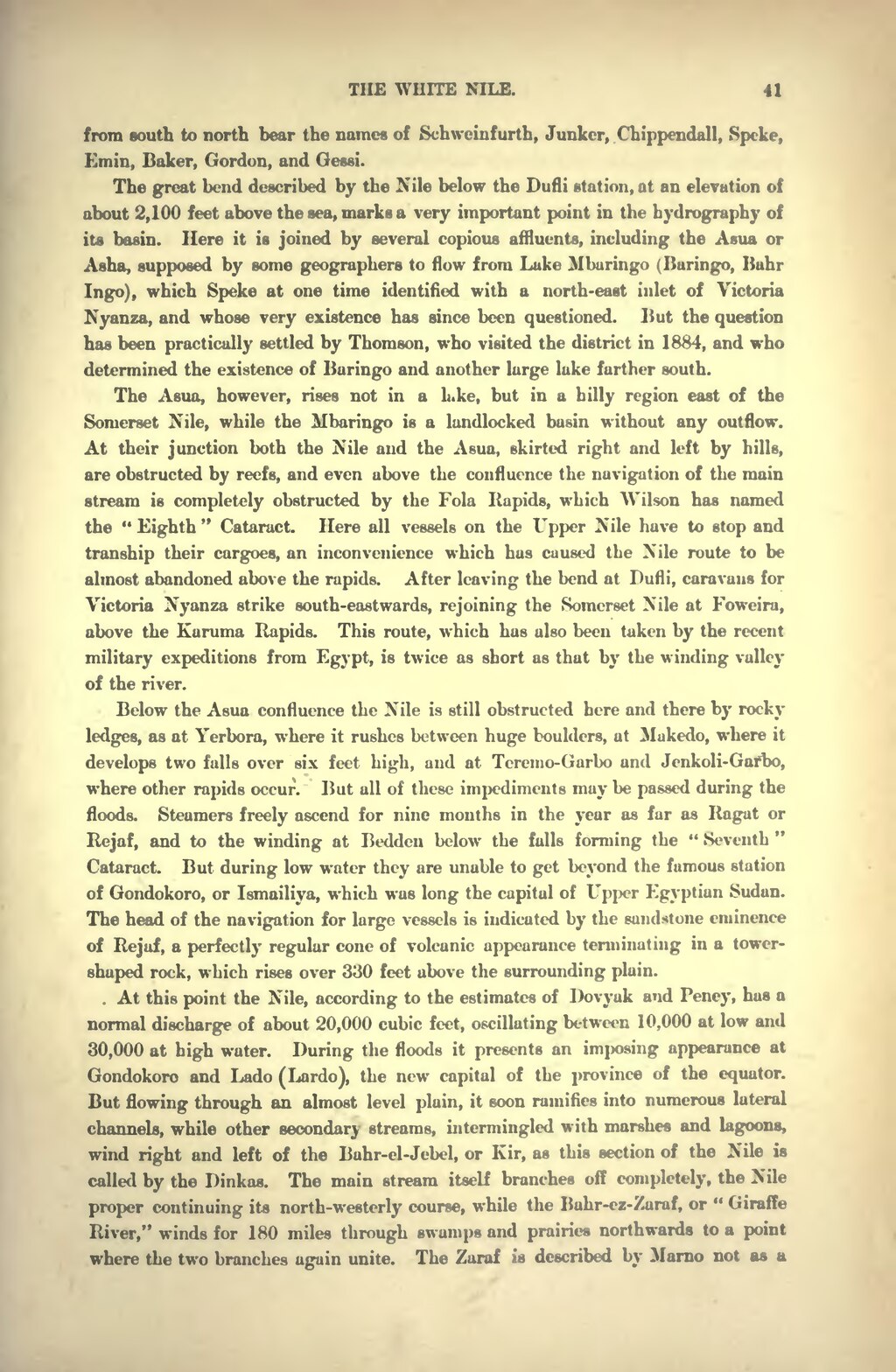from south to north bear the names of Schweinfurth, Junker, Chippendall, Speke, Emin, Baker, Gordon, and Gessi.
The great bend described by the Nile below the Dufli station, at an elevation of about 2,100 feet above the sea, marks a very important point in the hydrography of its basin. Here it is joined by several copious affluents, including the Asua or Asha, supposed by some geographers to flow from Lake Mbaringo (Baringo, Bahr Ingo), which Speke at one time identified with a north-east inlet of Victoria Nyanza, and whose very existence has since been questioned. But the question has been practically settled by Thomson, who visited the district in 1884, and who determined the existence of Baringo and another large lake farther south.
The Asua, however, rises not in a lake, but in a hilly region east of the Somerset Nile, while the Mbaringo is a landlocked basin without any outflow. At their junction both the Nile and the Asua, skirted right and left by hills, are obstructed by reefs, and even above the confluence the navigation of the main stream is completely obstructed by the Fola Rapids, which Wilson has named the "Eighth" Cataract. Here all vessels on the Upper Nile have to stop and tranship their cargoes, an inconvenience which has caused the Nile route to be almost abandoned above the rapids. After leaving the bend at Dufli, caravans for Victoria Nyanza strike south-eastwards, rejoining the Somerset Nile at Foweira, above the Karuma Kapids. This route, which has also been taken by the recent military expeditions from Egypt, is twice as short as that by the winding valley of the river.
Below the Asua confluence the Nile is still obstructed here and there by rocky ledges, as at Yerbora, where it rushes between huge boulders, at Makedo, where it develops two falls over six feet high, and at Teremo-Garbo and Jenkoli-Garbo, where other rapids occur. But all of these impediments may be passed during the floods. Steamers freely ascend for nine months in the year as far as Ragat or Rejaf, and to the winding at Bedden below the falls forming the "Seventh" Cataract. But during low water they are unable to get beyond the famous station of Gondokoro, or Ismailiya, which was long the capital of Upper Egyptian Sudan. The head of the navigation for large vessels is indicated by the sandstone eminence of Rejaf, a perfectly regular cone of volcanic appearance terminating in a tower-shaped rock, which rises over 330 feet above the surrounding plain.
At this point the Nile, according to the estimates of Dovyak and Peney, has a normal discharge of about 20,000 cubic feet, oscillating between 10,000 at low and 30,000 at high water. During the floods it presents an imposing appearance at Gondokoro and Lado (Lardo), the new capital of the province of the equator. But flowing through an almost level plain, it soon ramifies into numerous lateral channels, while other secondary streams, intermingled with marshes and lagoons, wind right and left of the Bahr-el-Jebel, or Kir, as this section of the Nile is called by the Dinkas. The main stream itself branches off completely, the Nile proper continuing its north-westerly course, while the Bahr-ez-Zaraf, or "Giraffe River," winds for 180 miles through swamps and prairies northwards to a point where the two branches again unite. The Zaraf is described by Marno not as a
